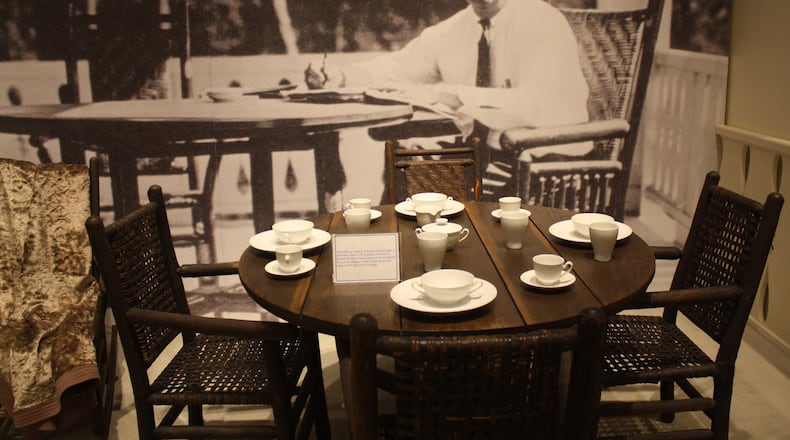The story of President Franklin D. Roosevelt’s retreat at Georgia’s Warm Springs is interwined with the history of the west Georgia city and the nearby mountain park that bears his name.
Roosevelt, whose home was in Hyde Park, N.Y., first came to Warm Springs in 1924 hoping the naturally warm water of the springs there (an average of 88 degrees) would help him recover from a crippling bout of polio that struck him a few years earlier.
After he became president, his cottage in Warm Springs became a Georgia White House for him, preserved today as his "Little White House," a museum. The Warm Springs National Historic Landmark District also includes cottages that were used by patients of the polio treatment center Roosevelt established in 1927.
The Little White House
The museum that was Roosevelt's residence in Warm Springs, beginning in 1932, was the second cottage FDR built for himself. The first, the McCarthy cottage, was featured in the 2005 TV movie, "Warm Springs." It was destroyed by a fire in 2011. The second cottage, which came to be known as "The Little White House," was built while FDR was governor of New York, before he was inaugurated as president in 1933.
Visitors to the state museum can see the house much as it was during Roosevelt's life. Included is Roosevelt's 1938 Ford covertible with specially made hand controls, his stagecoach and a theater. His voice as recorded in his famous radio speeches, called his "fireside chats," is played during tours.
> RELATED: FDR's life story from the New Georgia Encyclopedia
FDR’s funeral train
Roosevelt was visiting Warm Springs when he died suddenly on April 12, 1945 while still president. On this visit, he had been sitting for a portrait. The “Unfinished Portrait,” by artist Elizabeth Shoumatoff, is displayed in the museum.
After his death, a special funeral train carried the president’s casket from Warm Springs to Washington, D.C., including a stop in Atlanta.
The president’s casket was carried in its own train car, with a military honor guard. Honor guards of military units and members of the public gathered along the route of the train, including at Atlanta’s Terminal Station.
Roosevelt’s Historic Pools Museum
The Warm Springs historic site includes a museum that tells the story of the healing springs for which the city is named. The original spring-fed pools have been drained, but visitors can touch the warm water from a basin. The water comes from natural springs 3,800 feet below ground at nearby Pine Mountain.
The museum also tells about Roosevelt's Georgia Warm Springs Foundation and the nearby Warm Springs Institute, established by FDR to treat polio patients. After vaccines became available to eradicate polio in the United States, the facility took on a broader role to provide vocational rehabilitation training and services. It is now the Roosevelt Warm Springs Vocational Rehabilitation Campus.
Pine Mountain and F.D. Roosevelt State Park
Visitors to F.D. Roosevelt State Park in Pine Mountain can enjoy the scenery and mountain vistas much as they were was when Roosevelt spent time in Georgia. Dowdell's Knob on Pine Mountain offers a nice view of the valley below and was said to be FDR's favorite picnic spot. Roosevelt was said to enjoy visiting there during World War II because of the mountain's great beauty and serenity.
The park, located on land that Roosevelt owned, is built around the 1,395-foot-high peak of Pine Mountain, according to Explore Georgia, the state of Georgia tourism web site.
> RELATED: Learn more about F.D. Roosevelt State Park from Explore Georgia, the state tourism web site.
> RELATED: Take a road trip from Atlanta to visit Warm Springs
Credit: shari heinz
Credit: shari heinz
How often did Roosevelt visit Warm Springs?
According to the AJC's Actual Factual column, FDR was a frequent visitor to his Georgia retreat. "President Franklin D. Roosevelt loved visiting Warm Springs," according to the article, "making 41 trips to the west Georgia town and its soothing water (88 degrees) from 1924 -- eight years before being elected president -- until his death there in 1945, according to GeorgiaInfo (georgiainfo.galileo.usg.edu), an online almanac."
> RELATED: D-Day anniversary: FDR's prayer broadcast by radio after Normandy invasion
> RELATED: Photos of FDR and his Warm Springs presidential retreat
> RELATED: 3 Georgia sites for history buffs
About the Author
Keep Reading
The Latest
Featured




